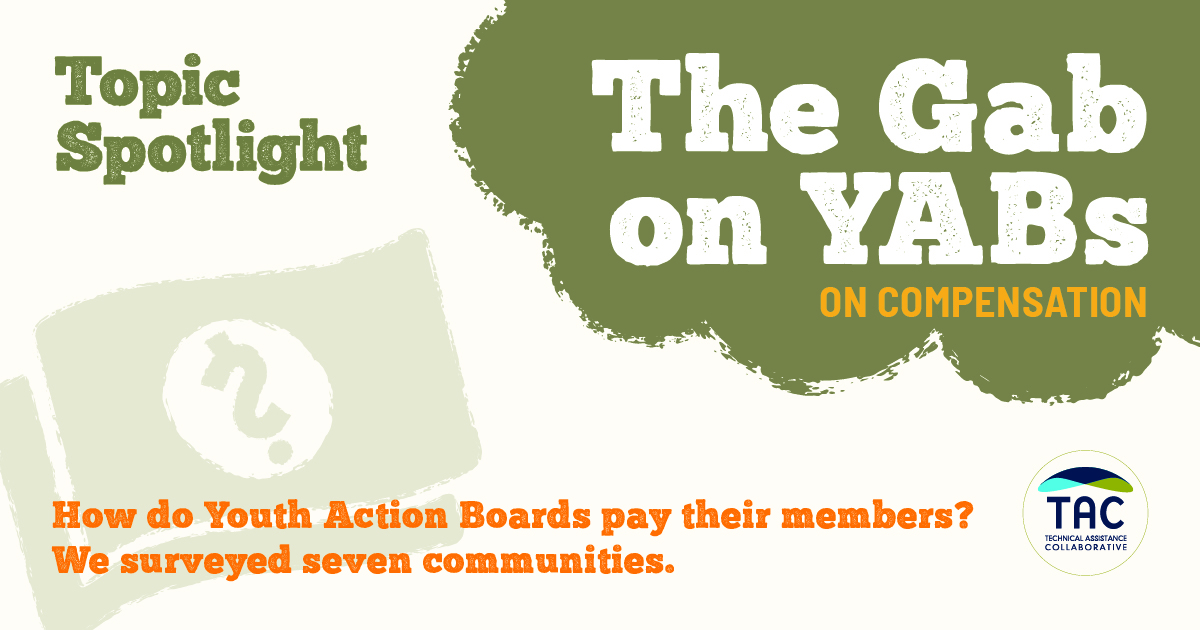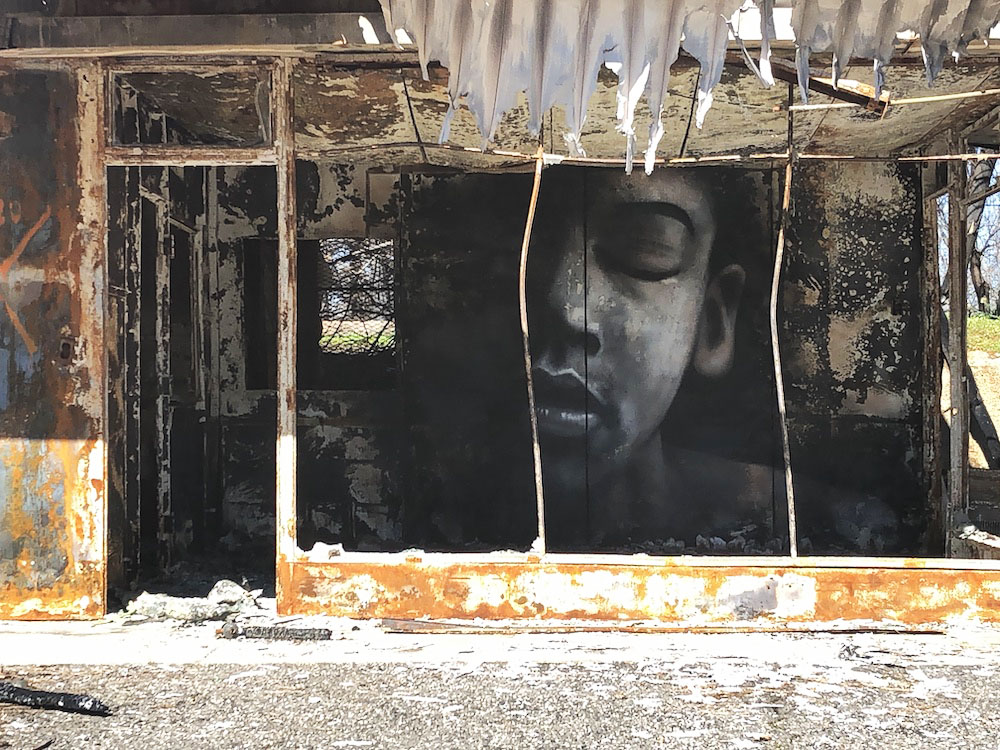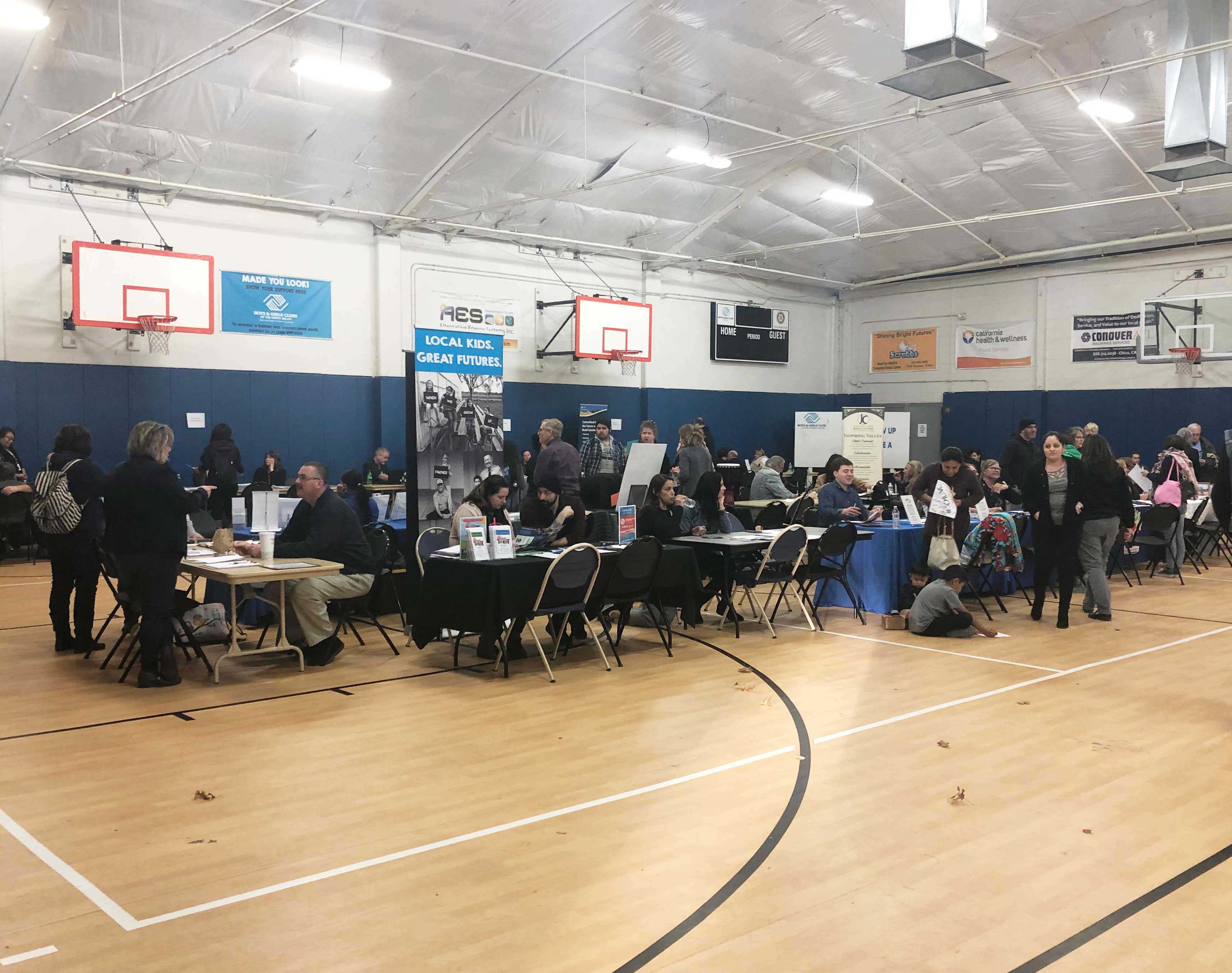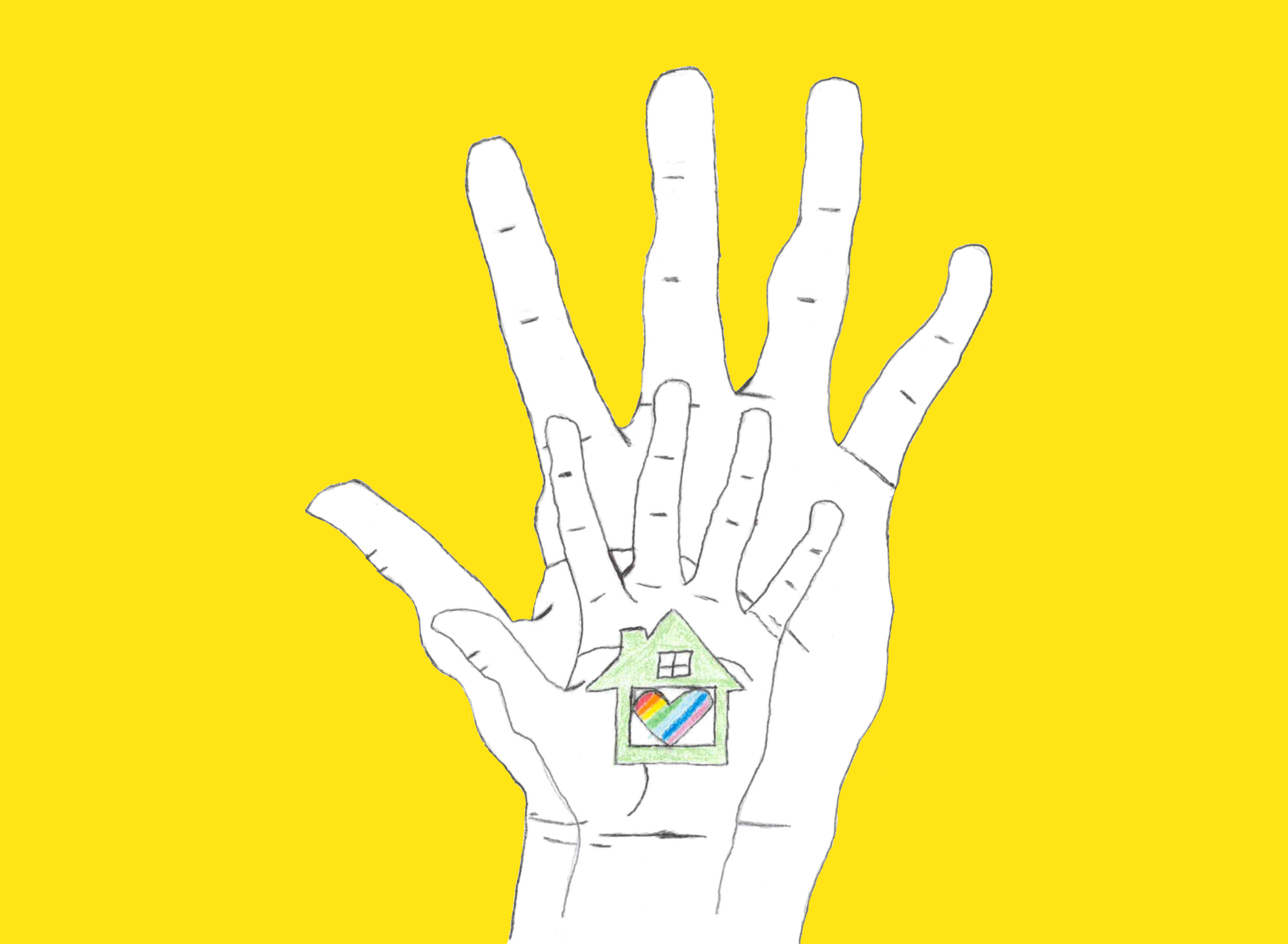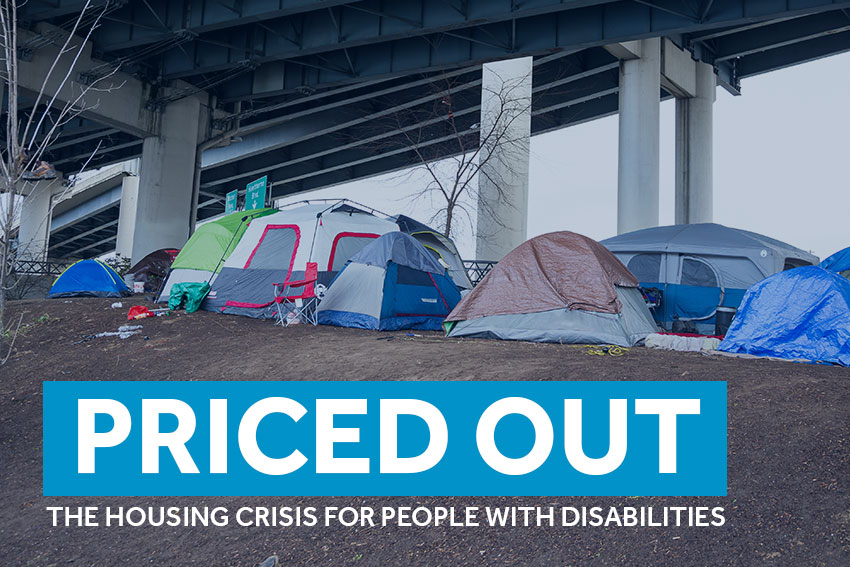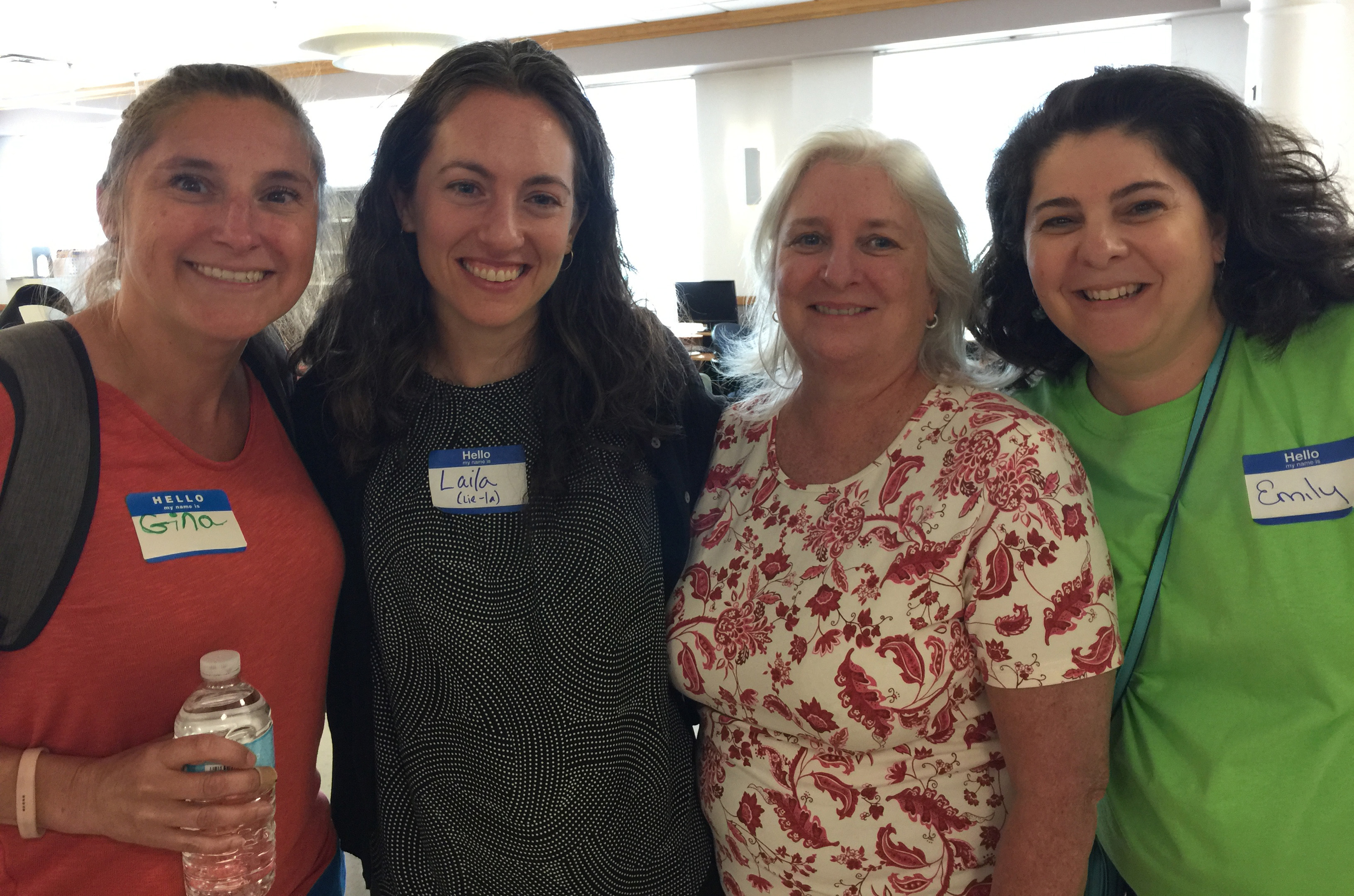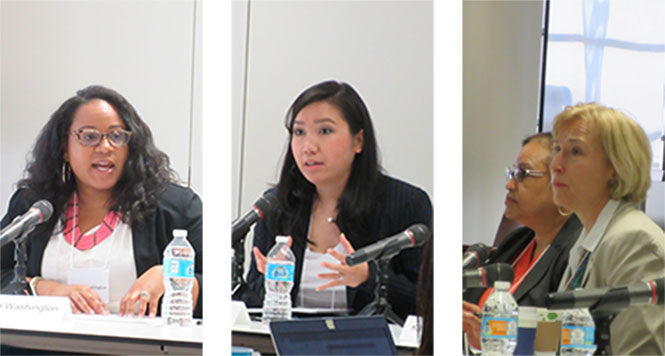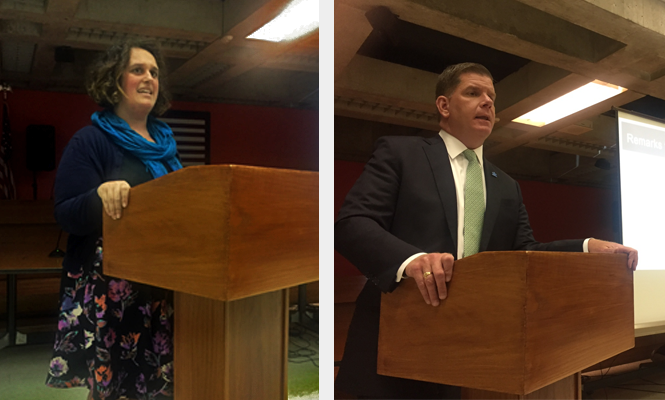Access: The TAC Blog
News, Resources, & Happenings at TAC: February 2020
Beyond Pizza — How Communities Handle Compensation and other Practical Issues with Young Adult Partners
Communities working to end youth homelessness are increasingly bringing youth and young adults with lived experience of homelessness to the forefront of their planning and implementation efforts, often with the support of a HUD Youth Homelessness Demonstration Program award. Of course, the young people who contribute their energy and insights should be compensated for their time - but how, and how much? TAC Senior Associate Lauren Knott, together with consultant Lauren Leonardis, surveyed a range of Youth Action Boards (YABs) to find out how they handle this and other challenges. The results are available as The Gab on YABs, a collection of community fact sheets and topic spotlights full of useful information for any community committed to fully incorporating youth and young adult leadership.
Tools for Successful State Partnerships between Medicaid and Housing Agencies
From 2016 to 2018, sixteen states participated in a Centers for Medicare and Medicaid Services (CMS) Innovation Accelerator Program (IAP) State Medicaid-Housing Agency Partnerships track. The tools developed and used to provide technical assistance to these states, incorporating the work and expertise of many TAC colleagues, form the basis of a new State Medicaid-Housing Agency Partnerships Toolkit published recently to the LTSS website. The toolkit is designed to assist states as they consider systems-level changes that further community integration, including the intersection between health care and housing. It is available for states to download, use, and adapt.
Trainings for Trainers in a Unique Rapid Resolution Pilot Program for Veterans
TAC has recently hosted several three-day events focused on homelessness diversion and rapid exit strategies for Veterans. These "train the trainers" sessions, conducted in partnership with the Cleveland Mediation Center and Abt Associates, are part of our support for the Department of Veterans Affairs' Supportive Services for Veteran Families (SSVF) program. Over the past two years, TAC and our partners have provided a wide range of onsite, remote, and training technical assistance in the development and rollout of SSVF's "Rapid Resolution" initiative, the first nationwide federal effort of its kind - a pilot program that supports diversion strategies for Veterans who are entering homelessness or have only recently become homeless. The recent trainings teach critical diversion and rapid exit skills in the context of SSVF's program design and implementation, with an emphasis on giving practitioners the tools they need to transfer that knowledge to their home communities. The training effort is led by TAC Senior Associate Douglas Tetrault, with strong support from other TAC staff members and TAC partners, and project direction from TAC Senior Consultant Jim Yates.
STAFF ACTIVITIES
TAC staff members Jenna Espinosa, Ellen Fitzpatrick, Ayana Gonzalez, Lauren Knott, & Ashley Mann-McLellan have been facilitating convenings and providing TA for Youth Homelessness Demonstration Program communities in Iowa, New York, Massachusetts, and Maine; Associate Ellen Fitzpatrick and Senior Associate Ashley Mann-McLellan conducted a 3-part training for Boston agency directors to strengthen the role of housing navigators in their organizations, and is helping the Boston Public Health Commission with a strategic plan to make its 800-bed shelter more housing-focused; Ashley was also one of 350 volunteers in Boston's 40th annual homeless census - thanks, Ashley! Senior Associate Melany Mondello led a training for the Vermont Balance of State Continuum of Care on the definition and documentation standards of chronic homelessness; Senior Consultant John O'Brien spoke about the future of policy and payment at a Substance Use Disorder Action Forum hosted by the Medicaid Transformation Project; Senior Associate Rachel Post facilitated the first cohort of Housing and Healthy Communities Learning Network, with plans for a second round in the works; Senior Associate Tyler Sadwith launched a provider-to-provider pilot program to test an approach for delivering TA on medication-assisted treatment to California's Tribal health programs; and Tyler also joined Senior Consultant John O'Brien to share strategic planning advice at a roundtable for Pew Charitable Trust's Substance Use Prevention and Treatment initiative.
STAFF TRANSITIONS
TAC is growing! A warm welcome to Project Support Specialists Laura Harris and Ari Rogers; Communications Designer Jeff Nguyen; Associates Eric Gammons and Jenna Espinosa in our housing group; and Dayana Simons and David de Voursney, two new Senior Consultants in our human services group. Learn more about our new colleagues on the TAC staff page.
The Gab on YABs: Youth Action Boards Report on How They Are Partnering with Communities to End Youth Homelessness
WHAT HAPPENS WHEN YOUNG PEOPLE who have directly experienced the challenges of homelessness or unsafe/unstable housing bring their expertise, passion, and creativity to the goal of transforming systems and ending youth homelessness?
- They bring reality-based understanding to existing homelessness efforts about the unique needs of youth in a given community.
- They model a core commitment to inclusion and equity that can be a struggle for older adults and more traditional systems of decision-making.
- They form an accepting, empowering community that strengthens the youth who participate.
- All this and more!
Across the U.S., rural, suburban, and urban communities that have made a commitment to end homelessness are learning how to understand and address the specific needs of youth and young adults. Just as with other populations in need of services and resources, the insights of those most directly affected — in this case, young people with lived experience of homelessness — are essential to finding solutions. This is why one of the key first steps is for a community to form a Youth Action Board that brings youth and young adults to the forefront of planning and implementation efforts.
Over the past few years, TAC has worked closely with many communities on their plans to end youth homelessness. At the center of each engagement has been the YAB, a decision-making entity made up of youth and young adults who have experienced or are experiencing homelessness. YABs provide leadership and guidance in partnership with other key stakeholders in the process of developing and implementing a plan to end to youth homelessness in the communities where they operate.
Every community is different, but there has been a great deal of interest in “what works” for others, and communities often have questions about best practices nationally for YABs. TAC has encountered YABs at all different stages — some well-established, some that have met formally for a short time, and others that have two or three core members identified, but haven’t yet taken the next step. So TAC decided to gather a sampling of YAB expertise as a guide for communities at all stages of YAB development.
Working with Lauren Leonardis, an independent consultant specializing in youth homelessness issues and a founding director of the large and active Boston YAB, we surveyed seven YABs, seeking to capture a snapshot of each one. The communities were asked about the big picture — their strengths and challenges — as well as the small details that push them forward like facilitation practices, budget, and recruitment efforts.
The results are fascinating and inspiring as they show diverse strategies, challenges, and opportunities in each unique community at the specific moment when the survey was answered. To share them, TAC has created The Gab on YABs: a series of fact sheets with an overview of each community, to be followed soon by a “topic spotlight” series looking at patterns and trends in areas of interest like compensation, structure, recruitment, and more.
We hope these resources will answer some of the questions communities have about how other YABs are making it work. No matter what stage your community has reached, The Gab on YABs can help you bring the voices and power of youth and young adults with lived experience of homelessness directly into all planning and implementation decisions.
April 2019: A Home, Defined by a Disaster — How Focusing on a Community’s Most Vulnerable Residents Can Transform Disaster Recovery Efforts
A home is so much more than a house, an apartment, or a couch at a friend’s place. A home means many different things to different people. But nowhere do we see “home” more wrongfully or woefully defined than in communities struggling to recover from a disaster.
The Stafford Act, which guides federal efforts in areas where a disaster has been declared, is focused on restoring people who are “disaster impacted” to their pre-disaster living conditions. When a storm damages a homeowner’s single-family dwelling, the path forward to restore that homeowner to their pre-disaster living conditions is relatively clear. But what about the same storm’s impact on people who were living on the street, or with family or friends? It is not as obvious how to restore such people to their pre-disaster living conditions. How do we help restore their homes when so many people responding to the disaster do not understand what their situations are? And even more importantly, how do we take disaster recovery a step further and begin to create more resilient communities?
I’ve worked in disaster recovery mode in Louisiana for over ten years, and more recently in North Carolina and California as well. But it only takes responding to one disaster to learn how powerfully the lowest-income members of a community are affected. In fact, a disaster’s effect on them is likely to involve a uniquely complex set of challenges because of their greater vulnerability to what is called “indirect impact.” For example, if a disaster takes public transportation off line for an extended period, a person without alternative options for getting to work might lose their job. Without that income, a couple of months later that person might lose whatever home they had, perhaps a room they rented in a friend’s apartment. This person may now experience episodes of literal homelessness, between short stays with family and friends. This can go on for years, if — as is the case in many areas — a rental market that was tight before the disaster becomes even more challenging.
How can we help this person recover from their disaster impact and return them to their pre-disaster state? And is that even the right thing to do?
The Second Wave
Even with the help of subsidy programs, people who were already experiencing homelessness before a disaster face increased difficulties finding housing afterwards, as the housing market is overwhelmed by displaced homeowners and renters. Rental rates surge quickly after a disaster — sometimes daily — and property owners may place more restrictions on which tenants they will accept. Some evict lower-income households in favor of tenants who can afford a higher rent. Such behavior can result in a secondary wave of people experiencing homelessness after a disaster. I’ve even seen some owners rent out disaster-damaged rental units without making any repairs, forcing families without other options to live in substandard conditions while paying exorbitant rent. The post-traumatic stress caused by such situations can exacerbate health conditions, lead to depression and substance use, and increase instances of domestic violence.
(Un)fortunately, a string of major disasters in the U.S. over recent years has opened up opportunities to develop more inclusive recovery strategies. And thanks to the Department of Housing and Urban Development, and in particular its Special Needs Assistance Programs (SNAPS) office, the definition of the official term “disaster-impacted” is at last beginning to expand.
Drawing on Homeless Services Expertise
After responding to multiple disasters, I can attest that each one is unique. What is not unique, however, is that as each temporary post-disaster recovery program eventually comes to an end, it is always the most vulnerable populations that are left behind — and too often, it is only then that homeless services leaders are brought into the disaster response. This must change. Those of us in the homelessness arena understand that every day is a disaster for people experiencing homelessness, and the knowledge and skills our field can bring should inform response and recovery efforts at every stage.
It used to be that I was only ever brought in at the end of a response to help all those people whom no one else was prepared to help, or who were not considered disaster-impacted, or who were imagined to be somehow gaming the system. (If you have never been inside a disaster shelter, I can tell you that it is not a home, and not somewhere people want to be.) These days, however, I am more often tapped while response and recovery plans are still being developed, and this represents real progress. I have taught Federal Emergency Management Agency (FEMA) officials what it means to be “couch surfing.” During the Great Flood of 2016 in Louisiana, those of us with homelessness expertise were able to help both HUD and FEMA to officially recognize and define the term “precariously housed.”
Looking Beyond Recovery
By helping those with the fewest resources to become more resilient, a community itself becomes stronger, too — and better prepared for overall disaster recovery. Strategies to support this goal include the development of mixed income rental housing with dedicated units for permanent supportive housing and for extremely low-income households; flexible rapid re-housing programs that provide case management services even after rental assistance ends; supportive services for persons with disabilities; and job creation for low- and moderate-income community members.
Disasters are awful tragedies for communities. However, Louisiana’s disaster-born permanent supportive housing program is a hallmark of recovery from hurricanes Katrina and Rita. You don’t have to go through a hurricane to create a permanent supportive housing program like Louisiana did. But if your community does experience a disaster that triggers an allocation of Community Development Block Grants for Disaster Recovery or other resources, then use that infusion to the best advantage! These resources can allow communities to rebuild beyond simply restoring pre-disaster conditions.
Until it is recognized that all of us are disaster-impacted just by virtue of living in a disaster-impacted area, there will be no equity in recovery efforts. We must think first of those who were already most vulnerable, and find ways not just to return them to their pre-disaster state, but to create more resilient people and communities.
Resource
HUD’s Disaster Recovery Homelessness Toolkit includes information and resources for local planning, immediate response, and disaster recovery.
Learn about TAC's technical assistance services in disaster preparedness and recovery.
News, Resources, & Happenings at TAC: March 2019
Improving Homelessness Response Systems in California’s Counties
Under a new contract with California’s Department of Housing and Community Development, TAC is providing capacity-building technical assistance (TA) to help California’s communities enhance their homeless crisis response systems. First, TAC staff traveled with state officials and TA peers to meet with homeless system representatives from around the state, learning about their needs and introducing potential TA resources. Since then, TAC has been engaged by several communities, including Butte County where we are helping with disaster recovery after the devastating 2018 Camp Fire.
In Vermont, a Focus on Ending Youth Homelessness
Through the U.S. Department of Housing and Urban Development, the Vermont Balance of State Continuum of Care became an official Youth Homelessness Demonstration Program site in the summer of 2018. This award provides support to the CoC and its Youth Action Board (YAB) as they develop a plan to prevent and end youth homelessness in 13 of Vermont's 14 counties. TAC Associates Lauren Knott and Ellen Fitzpatrick are helping CoC leaders to develop and drive the planning process - focusing especially on strengthening youth voice, analyzing local data, and defining the CoC's vision for the initiative. With the CoC's written plan to HUD submitted and now approved, TAC is now helping with project selection and the implementation process. TAC staff members were also fortunate to participate in a two-day Youth Collaboration training facilitated on-site by True Colors United and including both YAB members and CoC leaders. TAC has supported the Vermont Balance of State CoC as it incorporate takeaways from this training and creates a system in which authentic youth collaboration is at the forefront of all planning to prevent and end youth homelessness in Vermont.
TAC Staff in Action
STAFF ACTIVITIES
More than 700 leaders and managers from Supportive Services for Veteran Families (SSVF) grantee organizations attended five regional meetings in January, focused on rapid resolution — with TACsters Phil Allen, Ellen Fitzpatrick, Marie Herb, Ashley Mann-McLellan, Naomi Sweitzer, Douglas Tetrault, and Jim Yates providing coordination and giving presentations; Associate Ashley Mann-McLellan presented on “Designing Coordinated Entry Systems and Prioritization to Better Serve Individual Adults” at the Solutions for Individual Homeless Adults conference sponsored by the National Alliance to End Homelessness (BONUS: Check out Ashley’s blog post on what’s working in coordinated entry!); and Senior Associate Rachel Post led two sessions on Assertive Community Treatment and intensive case management at the Fairbanks (AK) Symposium on Homelessness.
News, Resources, & Happenings at TAC: January 2019
A Nevada Community Mobilizes to End Youth Homelessness
In 2017, Southern Nevada tallied the third highest rate of unaccompanied youth homelessness in the nation. Recognizing the urgent need for a dedicated response to this crisis, the community, which includes the city of Las Vegas, issued a national request for technical assistance proposals. Through this competitive process, TAC was selected to facilitate a robust and inclusive planning effort, and ultimately to draft the first-ever Southern Nevada Plan to End Youth Homelessness.
From April to October 2018, TAC consultants Lauren Knott, Ellen Fitzpatrick, and Ashley Mann-McLellan worked with the community to create decision-making groups, analyze data to identify areas of need, articulate goals and strategies, and strengthen the active involvement of "Young Adults in Charge" (the Southern Nevada Homeless Continuum of Care's official Youth Action Board) in guiding the development of the Plan.
This engagement culminated in a Summit to End Youth Homelessness, a packed and lively event at which the Plan was officially launched. Rounding out presentations by members of the planning group, TAC consultants facilitated brainstorming sessions for Summit participants on implementation of the Plan, focusing on next steps with identified strategies. Service providers, educators, law enforcement, policymakers, funders, faith groups, and business leaders were all in attendance, demonstrating this community's broad commitment to the shared goal of ending youth homelessness in Southern Nevada.
Meeting the Challenge of Expanding Access to Integrated Physical Health and Addiction Care
With support from the Melville Charitable Trust, TAC Senior Consultant John O'Brien assembled teams of experts to produce two new papers exploring the ways care integration is being practiced - and paid for - in a rapidly changing U.S. health care environment.
Rather than searching for a uniform set of requisite elements in the integration of substance use disorder (SUD) treatment and mainstream medical care, the authors of "Integrating Substance Use Disorder Treatment & Mainstream Medical Care: Four Ground-Level Experiences" decided to showcase a few very different groups of providers that have each moved in this direction. In each case, they asked the same key questions, including "What is the context in which your integrated care effort occurred?" "Why and how did the shift to integrated care come about?" and "What more should we know about integrated care?" A condensed version of this paper was published on the AcademyHealth Blog.
From 2000 to 2014, the rate of deaths in the U.S. from drug overdoses increased by 137 percent, yet access to treatment services for people with SUDs continues to lag. Expanding the capacity of primary care providers to assess and treat addiction is critical to filling this gap, especially given the stigma associated with seeking treatment in specialty settings. "Exploring Value-Based Payment to Encourage Substance Use Disorder Treatment in Primary Care," a joint publication project with the Center for Health Care Strategies, describes how several states and health plans are exploring value-based payment to promote SUD treatment in primary care, and offers considerations for others who might want to implement these models.
TAC Staff in Action
STAFF ACTIVITIES
Executive Director Kevin Martone moderated a plenary panel on "The Health of Housing: State and Community-Based Approaches" at the National Association of Medicaid Directors' fall conference (to see the panel, start at about 31:00), delivered the keynote address at the 20th anniversary gathering of the Supportive Housing Association of New Jersey, and led a workshop on Mainstream Housing Choice Vouchers at the National Association of Housing and Redevelopment Officials (NAHRO) conference; Senior Consultant John O'Brien has been named a distinguished adviser at the Pew Charitable Trusts and was recently interviewed by Pew on "How Health Care Payers Can Help Stem the Opioid Crisis"; Subcontractor Naomi Sweitzer led a well-attended event to promote the homeless preference in multifamily housing, held at Austin (TX) City Hall and hosted by Mayor Steve Adler; Associate Ashley Mann-McLellan facilitated workshops and leadership conversations with the Suburban Cook County (IL) CoC on maximizing the impact of rapid re-housing to end homelessness; Ashley also volunteered at Boston's annual Surge to End Chronic Homelessness event; Senior Consultant Jim Yates, Associate Phil Allen, and other partners from the Rural Supportive Housing Initiative traveled to Fairbanks, AK to help the community establish new permanent supportive housing units and house more families and individuals through a robust rapid re-housing program.
December 2018: Permanent Supportive Housing — Renewing Our Commitment
Last week, I had the pleasure of delivering the keynote address at the annual conference of the Supportive Housing Association of New Jersey. This gathering marked the association’s 20th anniversary, an opportunity to reflect on two decades of work to make permanent supportive housing — i.e., lease-based housing paired with voluntary, flexible services — a primary intervention for people with a wide range of disabilities and for people experiencing or at risk of homelessness. Many other states, too, have invested time and resources in the successful expansion of this approach for their homeless and disabled populations.
In an interesting fluke of timing, the New York Times had published an article the day before the conference, highlighting negative stories about permanent supportive housing (PSH) in New York and painting a picture of a model that had too often failed persons with serious mental illness. The tone of the article was keenly felt by this group of PSH practitioners, and several leaders from other states and policy groups have since contacted me to discuss the article’s potential impact. How could PSH — an approach that leaders in many states are working to expand in order to support the community integration needs of those who are homeless or disabled — be represented as a failure? What are the article’s implications for those seeking to invest in or expand PSH, for providers, and for people determined to live independently?
While the Times article was alarming, strong evidence nevertheless suggests that people with serious mental illness can succeed in PSH, and that use of the model should indeed be expanded. But there are considerations that must be addressed to ensure that PSH meets the needs of the people it is intended to serve.
Supportive Housing Works
People with serious mental illness have historically lived in institutional settings whether they actually needed to or not. Over time, however, understanding has grown that the policy of housing people in state psychiatric hospitals, for example, is both cost-ineffective and inhumane, and that it fails to demonstrate positive outcomes. Deinstitutionalization efforts from the 1970s to the 1990s meant that many more people with mental illness began living in the community. We all know the story of the resulting growth in homelessness and trans-institutionalization to correctional settings, as public systems failed to develop their community-based services capacity and affordable housing resources to meet the increase in demand. Some people had access to services and residential supports, but many did not, and many still do not today.
When I was a case manager over 20 years ago, "supportive housing" meant doing everything possible to get people with mental illness into housing and helping them stay there. Over time, anecdotal stories of success across the country evolved into an evidence base for what we now know as permanent supportive housing.
There is plenty of evidence to demonstrate the effectiveness of PSH for people with mental illness and for people transitioning from homelessness. Many PSH programs have shown increased housing stability, decreased emergency department and inpatient use, reduced jail days, and significant cost savings compared to homelessness, inpatient care, and other institutional or supervised settings.
Even the statistics noted by the Times suggest that a large majority of people have succeeded in supportive housing. It is important to regard this in light of evidence showing safety and quality of care concerns in New York's adult homes, the housing situation from which many people with mental illness move into supportive housing.
Services Must Be Well-Designed and Adequately Funded
Does supportive housing work for everyone? No. Some people need supervised treatment settings, or prefer group residential programs. However, contrary to the assumptions that used to govern our mental health care systems, supportive housing in the community has been shown to work for a variety of people, including those with the most significant needs who are transitioning from state psychiatric hospitals, nursing facilities, jails, or homelessness. Even people with the most complex conditions need a place to call home that is not contingent on being a "compliant" patient or a "good" client; in fact, providing a choice of housing together with voluntary services has been shown to strengthen retention in housing and services.
In order for PSH to be successful, particularly for persons with complex needs, services must be voluntary, flexible, responsive, robust, and comprehensive. Furthermore, they must be delivered by well-trained staff who are able to provide the right types of services, in the right locations (i.e., where people live), and at the right times, adapting what is offered to meet individuals’ evolving needs. Providers that struggle to adequately support people in PSH are often those with inadequate staffing, which makes them unable to respond quickly and appropriately.
To underfund services is to undermine the ability of providers to meet the needs of PSH tenants. In my experience, the services covered by Medicaid are not, on their own, enough to meet the needs of many people who could otherwise succeed in PSH. If systems will be expected to serve an increasingly complex population, state and county funding agencies and Medicaid managed care organizations must have adequate resources available to pay for a full range of services; successful permanent supportive housing programs are those that braid or blend Medicaid with other resources.
Building On the Evidence
As a former state mental health commissioner, a behavioral health provider, and the family member of someone with a mental illness, it boggles my mind that we would rather pay several hundred thousand dollars per year to house a person in an institutional setting than commit a fraction of that amount to support them in an integrated, community-based setting with demonstrated positive outcomes. Too often, the response to challenges that arise in PSH is an assumption that a person is "not ready," or "needs supervision," instead of a person-centered mindset that tailors and continually adapts services to each individual’s needs and choices.
Yes, people with mental illness and other disabilities may need inpatient treatment, at times. They may need round-the-clock support, at times. They may need assistance with their medications, at times. They may need transportation to medical appointments, at times. People with mental illness and other disabilities may need lots of things — but that doesn’t mean we should return to institutionalization at a cost that is much greater than the sum required to meet all of those needs. With sufficient resources to pay for both rental assistance and robust, flexible services, permanent supportive housing can be a primary intervention for individuals with complex needs.
Systems should move forward on bringing well-designed, fully funded permanent supportive housing to scale, so that all who can benefit from living in safe, independent, community-integrated housing have the opportunity to do so.
November 2018: News, Resources, & Happenings at TAC
A Community Focuses on Solutions to Rising Homelessness
IN LANE COUNTY, OREGON AND ITS LARGEST CITY, EUGENE, service providers, community stakeholders, and elected officials are coming together to improve the community's response to a growing population of people experiencing homelessness. To help understand the problem better, and to identify potential solutions and best practices, the Lane County Department of Health and Human Services engaged TAC in March to conduct a public shelter feasibility study. With the study, the community sought to learn how people enter into homelessness in Lane County, which housing and services they are able to access, and what factors might be contributing to any system bottlenecks.
Over the past seven months, TAC consultants Gina Schaak, Liz Stewart, and Douglas Tetrault have worked to assess Lane County's homeless crisis response and service systems, focusing on both resource capacity and gaps in coordinated entry, diversion, outreach, day shelter, emergency shelter, transitional housing, rapid-rehousing, and permanent supportive housing. To get a comprehensive picture of the existing system, TAC met with Lane County and City of Eugene staff, conducted interviews and focus groups with service providers and other key community stakeholders, and - with the help of the Human Services Research Institute - analyzed data from numerous sources.
On October 10, Liz, Gina, and Douglas presented TAC's preliminary findings to a joint session of Lane County Commissioners and the Eugene City Council, and later that day to community members at a well-attended public forum. TAC explained that Lane County can significantly reduce homelessness best by strengthening all system components. By improving the alignment of policy and training, and consistently implementing best practices throughout both Lane County and Eugene, the community can ensure that its resources are applied effectively. In December, TAC will deliver a final report authored by Liz, Gina, Douglas, and TAC Senior Consultant Lisa Sloane, with specific recommendations on system and policy changes as well as results of system modeling.
Second Annual Rapid Re-Housing Institutes Energize Providers from Across the Country
In partnership with the Department of Veterans Affairs (VA), the Department of Housing and Urban Development (HUD), and the U.S. Interagency Council on Homelessness, TAC designed and delivered the second annual Rapid Re-Housing Institutes last month. Held in Miami, FL and San Diego, CA, these intensive two-day trainings brought together over 800 rapid re-housing practitioners, Continuum of Care leads, government officials, philanthropic groups, and federal partners. Sponsored primarily by the VA's Supportive Services for Veteran Families (SSVF) program, the Institutes focused on rapid re-housing practice and planning, homelessness diversion and rapid exit strategies, and coordinated entry practices. Emerging topics such as shared housing solutions, data-informed system design, and sustainable homeless crisis response systems were also highlighted. TAC, along with our partner Abt Associates, is the primary technical assistance (TA) provider for SSVF, working closely with national partners and other TA firms to deliver high-quality planning and training development for grantees of the program. The Institutes are the only event of their kind to deliberately target both SSVF nonprofit providers and homeless service providers funded by HUD and local groups.
TAC Staff in Action
STAFF ACTIVITIES
TAC Executive Director Kevin Martone co-led a workshop on mainstream vouchers at the annual conference of the National Association of Housing & Redevelopment Officials; Kevin also joined Senior Associate Rachel Post and frequent TAC collaborator Jacob Mihalak to moderate and present in several panels at last month's Supportive Housing and Supported Employment post-conference institute after the Washington State Co-Occurring Disorders and Treatment conference; Rachel also presented at the Washington Council on Behavioral Health's Peer Pathways 2018 conference on supported employment and supportive housing for justice-involved populations, and at the Oregon Housing Conference on the role of supported employment in promoting recovery for people in supported housing.
STAFF TRANSITIONS
We are delighted to welcome two new Senior Associates to TAC! Tyler Sadwith joins TAC's Human Services practice, after over seven years at the Center for Medicare and Medicaid Services advancing strategies to help states introduce behavioral health system reforms and address complex policy, operational, and strategic challenges. Nicole Sweazy will work with our Housing practice, bringing nearly two decades of expertise in affordable housing and federal programs; as Executive Director of the Louisiana Housing Authority, she oversaw the state's permanent supportive housing and homeless programs and was responsible for developing Louisiana's plan to end homelessness.
September 2018: News, Resources, & Happenings at TAC
New Mainstream Housing Voucher Awards Announced
Last week, the U.S. Department of Housing and Urban Development (HUD) announced the award of almost $100 million in Mainstream Housing Choice Vouchers (HCVs) to 285 public housing authorities in 45 states, the District of Columbia, and Guam. As HUD noted in its press release, the availability of 12,000 new vouchers for non-elderly, low-income people with disabilities "helps to further the goals of the Americans with Disabilities Act by helping persons with disabilities live in the most integrated setting."
Housing agencies must target these new vouchers to at least one of the following groups of people with disabilities:
- People transitioning out of institutional or other segregated settings
- People at serious risk of institutionalization
- People experiencing homelessness
- People at risk of becoming homeless
In its application scoring system, HUD provided significant incentives for public housing authorities (PHAs) to partner with state or local agencies that work with these populations. To help foster such collaborations, TAC and the National Alliance to End Homelessness, the National Association of Housing and Redevelopment Officials, the National Council of State Housing Agencies, and the Consortium for Citizens with Disabilities co-hosted a series of outreach webinars for service providers, Continuums of Care (CoCs), and disability rights advocates as well as PHA leadership. More than 1,200 PHAs, CoCs, disability organizations, and other local partners participated in preparation for the application process.
What's Next?
Nearly $300 million in HUD's FY 2018 budget for the Mainstream HCV program remains. What does this mean for your community?
Apply: If your community did not apply for funds, start laying the groundwork now for your response to the next opportunity, which is likely to be in the near future.
Reapply: If you applied this summer but did not receive funding, request a debriefing from HUD (as described in the Notice of Funding Availability).
Reach out to your local PHA: Housing authorities that have been awarded vouchers will need the assistance of local homeless, disability, and other service agencies to implement this program effectively!
As TAC's recent report Priced Out: The Housing Crisis for People with Disabilities documents, non-elderly adults with disabilities living on Supplemental Security Income are confronting a housing affordability gap across our nation. These new federal funds can help close the gap for people with disabilities in your community.
TAC Staff in Action
STAFF ACTIVITIES
TAC Associate Phil Allen teamed up with Bill Burns, director of Family Promise of Onterio County, NY, to bike 100 miles in the 2018 Point to Point ride, raising over $1,000 for the Vermont Foodbank; As part of TAC's work with the Nevada Partnership for Homeless Youth, Associates Ellen Fitzpatrick and Lauren Knott facilitated a meeting in Las Vegas with juvenile justice and child welfare system representatives, youth service providers, young people who have experienced homelessness, and other stakeholders to determine objectives and strategies to include in the group's plan to end youth homelessness in Southern Nevada; Through the Department of Veterans Affairs' Supportive Services for Veteran Families program, Managing Director Marie Herb, Senior Consultant Jim Yates, Associates Phil Allen and Douglas Tetrault, and contractor Naomi Sweitzer have conducted launch meetings throughout the summer in communities that are part of a pilot program focused on rapid resolution of housing crises; Executive Director Kevin Martone participated in Monarch Housing Associates' New Jersey Hill Day in Washington, DC to advocate for strong housing assistance programs; Administrative Assistant Mayra Pabon started as a volunteer at Horizons for Homeless Children; Mayra also represented TAC at a celebration event for graduates of the Boston Center for Independent Living's Transitions Internship Program, including TAC summer intern Jordon Myers (see below).
STAFF TRANSITIONS
We are happy to announce the addition of two new Senior Associates to the TAC team. Rachel Post, who will work with the Human Services Group, is based in Portland, OR where she has worked both locally and nationally on programs to improve social determinants of health. At TAC, Rachel will provide consultation and support for initiatives that create and sustain integrated health, behavioral health, employment, and housing programs and services for vulnerable populations. Ayana Dilday Gonzalez, who is joining our Housing Group, will be based here in our Boston office; Ayana brings extensive state-level leadership experience developing and maintaining supportive housing projects, and will be working with us on HUD's CoC and 811 Project-based Rental Assistance programs and other HUD multifamily housing Initiatives.
Congratulations to Francine Arienti on her new role as TAC's Human Services Director, and to Associate Ashley Mann-McLellan on her new role as a mom! Welcome to the world, Zoe McLellan!
And finally, thanks and farewell to summer intern Jordon Myers, a Framingham State University student who joined us through the Boston Center for Independent Living's Transitions Internship Program.
January 2018: We Need All of Us: Tips for Continuums of Care Working to Include People with Lived Experience of Homelessness
IT IS NOW WIDELY ACCEPTED that planning and implementing successful programs to prevent and end homelessness requires direct involvement by people who have themselves been homeless. Individuals with this lived experience, often referred to as “consumers” because of their direct interactions with homeless services, bring a well-informed awareness of the supports that are most needed and desired. Many valued innovations, such as the Housing First approach, are based on consumer preferences shared through interactions and studies.
Continuums of Care (CoCs) — collaborative planning bodies funded by the U.S. Department of Housing and Urban Development to improve homeless service coordination in specific geographic areas or communities — are required to include on their decision-making boards people who are or have been homeless, along with key stakeholders from nonprofit provider organizations, local government agencies, philanthropic organizations, and local businesses. Furthermore, any agency that receives funding through the CoC program must include a person who is homeless or formerly homeless on its own board or other policymaking entity.
However, many CoCs and agencies receiving CoC funds lack well-developed consumer involvement strategies. In response to a 2015 survey, 47 percent of CoCs said consumers influence some decisions, while only about 15 percent indicated that consumers influence all major decisions. Some CoC respondents reported that they want to involve consumers to a greater extent, but are challenged to find people who have enough “interest and stability” to be actively and consistently involved.
In 2016, the United States Interagency Council on Homelessness reported on a gathering of consumer advocates convened to discuss how decision-making bodies can create a welcoming environment for people with lived experience of homelessness. Based on these findings, together with insights from research on mental health consumer involvement, we’ve put together some tips to help you first build interest and excitement among homeless and formerly homeless people to become actively involved, and then to make sure this involvement is a positive experience for all.
Generate Interest
Clearly “advertise” what the role is and why it is important. For a CoC board, what is the time commitment? What does the board do? For a CoC-funded agency, what input is the agency seeking?
Develop and maintain strong connections to trusted community organizations that provide housing and services to people who are homeless. These partners can identify potential candidates and encourage participation.
Financially compensate board members with lived experience of homelessness for time and travel in a similar fashion to others serving in the same capacity.
Explain responsibilities, reimbursement policies, the time commitment expected, and options for participating in different ways, such as attending meetings or reviewing draft materials. It may be helpful to use the term “like a job” to clarify the level of expectation.
Establish Stability
Language matters! Use “people first” language in all your materials and communications, such as “people who are experiencing homelessness” rather than “the homeless.” Consider your language choices when talking about subpopulations as well, for instance saying “young adults” rather than “kids” when talking about young people experiencing homelessness.
Identify and resolve any barriers to participation, like scheduling conflicts with employment, lack of access to transportation, or the need for child care. Devote part of each meeting to addressing these barriers, and meet with people individually as needed to problem-solve. Consider non-traditional meeting times to accommodate these needs, such as in the evenings or on the weekends. Meet in locations that are accessible by public transportation, and offer child care or child-friendly meeting spaces.
Designate a point person for questions and concerns. This person should check in regularly with the consumer to make sure they understand the board or committee’s processes (meeting agendas, voting procedures) and the content to be discussed during each meeting. It’s also important to bring people up to date on what happened at any meetings they missed. Offer opportunities to provide input in ways besides speaking publicly at a meeting, such as in writing or via email before or after meetings. Individualized connections like this may be especially important when working with board/committee members who have a serious mental illness.
Make every effort to accommodate consumers’ needs, particularly in relation to health difficulties. For people with disabilities, accommodations should include a physically accessible room, materials in appropriate formats (e.g., large print, Braille), and access to Communication Access Realtime Translator (CART) and American Sign Language (ASL) interpreters. The meeting’s facilitator may need to be deliberate in making the space for members with disabilities to be heard – especially those with mental health conditions. As noted earlier, making meetings child-friendly or offering child care can enable participation by people with young children.
Eliminate tokenism by recruiting more than one person with lived experience, and offer other opportunities for inclusion as well. Invite people to suggest ways in which they would like to contribute, and work to create an environment that actively engages and solicits the input of all members of the group, including those with differing communication capacities.
Learn Together
Value consumers and their perspectives regardless of what led to their experience of homelessness.
Include a cross-training component, in which each advisory board member takes five to ten minutes to explain to the group the expertise they have to offer, which for some members will include their lived experience of homelessness. Ensure that this time does not turn into a “job interview” format where members are merely listing qualifications.
Create opportunities for informal interactions between consumers and other committee members, such as sponsoring and paying for group lunches and social outings.
Consider ways to bring people with lived experience of homelessness into leadership roles within your CoC, through the board and committee membership, or by spearheading specific CoC initiatives. Establish a clear process for those who may be interested and invest time in actively recruiting members.
Make sure everyone is up to speed before shifting gears or making decisions. This includes educating consumer members on the basics of the CoC, and defining common terms and acronyms. Try to use plain, non-specialized language in meetings. Consider making decisions by consensus through group discussion, rather than by majority vote.
It can be challenging for any group to work together across significant differences in background and experience. But it’s worth it! To make their programs as effective as possible, CoCs need the insights and ideas of people with current or recent experiences of homelessness. In turn, the organizational leaders and policymakers who serve on a CoC or agency board offer connections, knowledge, and authority — valuable resources to which consumers on their own often lack access. Continuums of Care that rise to the challenge of fully incorporating people with lived experience of homelessness will be all the stronger for it.
Helpful Resources:
A Quick Guide on Consumer Engagement in Governance of Health Care for the Homeless Projects (2016, National Health Care for the Homeless Council).
Guidance for Consumer Advisory Board Staff Support [on Homlessness Projects] (2017, National Health Care for the Homeless Council).
Nothing About Us Without Us: Seven Principles for Leadership and Inclusion of People with Lived Experience of Homelessness (2016, Lived Experience Advisory Council of the Canadian Obervatory on Homelessness).
Recommendations for Effective Implementation of the HEARTH Act Continuum of Care Regulations (2012, National Alliance to End Homelessness)
Youth Collaboration Toolkit (2017, True Colors Fund)
Thanks to TAC Associate Lauren Knott for her assistance with this post!
December 2017: Affordable Housing for People with Disabilities
The tenth edition of the Priced Out: The Housing Crisis for People with Disabilities report, released today by TAC and our partners at the Consortium for Citizens with Disabilities Housing Task Force, once again demonstrates that non-elderly adults with disabilities who rely on Supplemental Security Income (SSI) are among the groups most severely affected by the extreme shortage of affordable rental housing across our nation.
Over the last decade, increased rental demand combined with development primarily at the high end of the market has led to record-low vacancy rates, higher rents, and increased competition for affordable and subsidized housing. This overall market trend is reflected in the ever-worsening affordability gap for extremely low-income renters with disabilities.
Supplemental Security Income is the federal income maintenance program that assists people with significant and long-term disabilities who have virtually no assets and — in most instances — no other source of income. The national average rent for a studio/efficiency unit in 2016 was $752, equal to 99% of a monthly SSI payment. In thirteen states and the District of Columbia, areas with the highest housing costs in the nation, the average studio/efficiency rent exceeded 100% of the income of an SSI recipient.
This housing affordability crisis deprives hundreds of thousands of people with disabilities of a basic human need: a place of their own to call home. Because of the disparity between SSI income and rental housing costs, non-elderly adults with significant disabilities in our nation are often forced into homelessness or segregated, restrictive, and costly institutional settings such as psychiatric hospitals, adult care homes, nursing homes, or jails.
Ideally, there would be enough job opportunities that match the skills of people with disabilities and pay a livable wage so that all could afford housing in their communities. However, as the National Low Income Housing Coalition documents in its 2017 Out of Reach report, it would require more than two full-time jobs at the federal minimum wage to pay for a one-bedroom apartment at fair market rent.
Federal rental assistance — meaning a subsidy that helps renters pay no more than 30% of their income for housing — is the key to solving the housing crisis that has been documented in Priced Out reports over the past 19 years. Unfortunately, because of funding limitations that have grown worse in recent years, federal rental subsidy programs currently reach only 35 of every 100 extremely low-income households; with incomes equal to only 20% of area median income, one-person households receiving SSI fall within this category. This shortfall translates into long waiting lists at Public Housing Agencies and affordable housing developments, and a critical shortage of permanent supportive housing opportunities for people with significant disabilities who have SSI-level incomes.
A unified advocacy effort by the disability community is needed to support and potentially expand permanent supportive housing programs along with other rental assistance strategies. Providing housing assistance to people with the most significant and long-term disabilities is not only the right thing to do, but is also more cost-effective than perpetuating the alternatives: costly institutional care, uncontrolled expenses to the health care system, and homelessness.
December 2017: Coordinated Entry — What's Working Well
FOR SEVERAL YEARS, TAC consultants have been on a journey with communities to create effective, sound Coordinated Entry (CE) systems and processes that contribute to their larger goal of ending homelessness. As the U.S. Department of Housing and Urban Development’s (HUD) January 23, 2018 deadline for Coordinated Entry compliance nears, we want to share some planning tips that we have seen contribute to creative and efficient systems.
Align Your Local Goals to End Homelessness WITH HUD’s Goals for Coordinated Entry
We often see communities concerned about the compliance aspect of Coordinated Entry, which leads them to direct planning efforts toward the goal of “checking off the boxes” of Coordinated Entry requirements. We challenge communities instead to consider Coordinated Entry a powerful tool in their efforts to end homelessness. HUD promotes some key strategies that really are essential in reducing and ending homelessness, such as ensuring that all processes are as low-barrier as possible, implementing uniform assessment to ensure uniform decision-making across systems, and prioritizing assistance to the most vulnerable. Some planning activities to align your own local goals with the goals of Coordinated Entry might be helpful:
-
Create a crosswalk between key goals in your local strategic plan to end homelessness and those in HUD’s Coordinated Entry Notice.
-
Spend some time with your stakeholders envisioning your ideal system for any consumer. Draw on this process to create a list of values that will guide decision-making throughout the CE planning process.
-
Engage local funders to be part of planning efforts by finding alignment between their goals and your CE goals.
Integrate Change Management Strategies into Planning
Implementing Coordinated Entry is a significant systems change, and will continue to have effects long past a community’s first iteration of CE. It is important to acknowledge the shift that stakeholders will undergo, and to use change management strategies that can strengthen the planning process:
-
Continually acknowledge the change that is happening. This will start to normalize the process, making the reality of systems change familiar to your stakeholders.
-
Engage your stakeholders in creating the system, or in problem-solving any challenges that arise. People often respond better to change if they are part of the thought process, rather than having change forced upon them.
-
Work to create a culture of innovation and “failing forward.” It’s good to make use of reference materials to guide Coordinated Entry planning processes, but the bottom line is that there is no pre-packaged Coordinated Entry system with assembly instructions. Each community must figure out what works given its own local stakeholders, populations, and conditions. A learning culture that celebrates innovation can help to promote new ideas and reduce negative backlash toward methods that were tried but did not succeed. We are seeing this type of culture work well particularly in the development of diversion techniques within Coordinated Entry.
Promote Fidelity to Housing First
The guiding principles of the Housing First philosophy are critical to creating flow through your Coordinated Entry system. Practices such as lowering barriers to housing admission, creating housing pathways and processes with a commitment to referral success, fostering participant choice, prioritizing assistance to the most vulnerable, and terminating participants from housing programs only in the most egregious cases not only create system flow, but also poise communities to improve their success in several of HUD’s system performance measures. To maintain fidelity to Housing First, there are several actions your community can take:
-
Incorporate consumers into your planning process. Communities have found many ways to infuse consumer voices into planning in a meaningful way. Often the key is to employ several strategies at once: hold multiple seats for consumers on your planning committees and Continuum of Care board; create a consumer advisory body to receive an even more diverse set of viewpoints; hold focus groups with consumers who may not be able to commit to an ongoing committee, but who would like to give input; and compensate consumers for their time.
-
Continually assess programs’ fidelity to Housing First. Programs may incorporate self-assessments, such as the Housing First Assessment recently released by HUD, to gauge current fidelity and identify areas for improvement. Many communities have also found success in setting up learning collaboratives for both frontline and manager-level program staff to share strategies in implementing a Housing First philosophy.
-
Get funders trained and engaged in Housing First. At TAC, we have done substantial work with communities’ funders to assist them in aligning their contracts, performance targets, and monitoring processes with the Housing First philosophy. Getting funders on board helps with the promotion of Housing First not only at a program level, but at a systems level.
We are continually impressed by the perseverance we have seen in communities to create Coordinated Entry systems and processes that can drive progress towards ending homelessness. We look forward to continuing to learn alongside you!
June 2017: Putting the Pieces Together
Even though “Bill” showed up right on time for Boston’s Third Surge to End Chronic Homelessness, he told me that he "thought it was going to be stunt, a lot of talking but nothing to show for it.” But when Bill left the building — some seven hours after I greeted him as his assigned ambassador for the day — he had plenty to show for his efforts: a doctor and an appointment, an insurance provider, and best of all his own apartment. It was clear that this was no stunt but an incredible collaboration between the Commonwealth of Massachusetts, the City of Boston, and lots and lots of providers and volunteers.
Behind the Scenes
In many ways, an event like this is just plain old common sense: Bring together all the players — MassHealth/Medicaid, Social Security, the Boston Housing Authority, the Metropolitan Boston Housing Partnership, accountable care organizations, homeless service providers, housing navigators, and the people who need what all of them have to offer — to resolve the barriers that have kept Boston's chronically homeless individuals from finding and keeping housing. But that view is just like looking at the face of the watch and not seeing all the intricacies that hide behind it.
Led by the Massachusetts Department of Elder Affairs and Boston's Department of Neighborhood Development, the Boston Surge was the product of months of detailed planning and collaboration. Data was shared between MassHealth and homeless shelter and outreach providers, and matched to identify individuals over age 50 who had been living on the streets or in homeless shelters for a year or more or who had experienced homelessness several times over the past few years. Some of these individuals were currently on Medicaid while others had previously been, but were no longer active. For the Third Surge, 124 individuals were invited and encouraged and supported to participate. Meanwhile, the Boston Housing Authority and the Metropolitan Boston Housing Partnership looked through their portfolios of housing units and subsidies to identify available housing resources. An individualized "passport" with potential options of health care and support services was created for each person before the event.
The Big Day
Finally, on the day of the Surge, the teams arrived. Representing Social Security, MassHealth, the Housing Authority, service providers, and accountable care organizations, they brought computers, printers, and a determination to get the job done. Ambassadors (all volunteers like myself) were each connected to one "guest" and walked them through the process. The day was busy, chaotic at times, but filled with an energy and a collective sense of will to get people housed. There were no photo ops, no speeches — there was too much work to do.
More than half of the people experiencing chronic homelessness who had been invited — a strong turnout — came to the event. Bill and I got to know one another over breakfast. A Boston native, he fell on hard times two years ago, lost his housing, and had been living in a shelter ever since. On the spot, we got Bill's social security documentation printed out. We met with several providers from senior care organizations, and he signed up for health services, supportive services, and a primary care physician.
Next, we filled out the Boston Housing Authority application and waited while staff reviewed Bill's criminal background records and other eligibility requirements. We sat outside the room and smiled each time we heard clapping indicating that someone had received a housing unit. Then it was Bill's turn. He was told he was eligible, and then got to pick a housing development that met his needs. The applause was for him this time. He sat there just saying over and over, "I thought this was going to be a stunt, I can't believe it!"
Real Results
Boston’s Third Surge to End Chronic Homelessness produced impressive results. Forty-two elders left this one-day event with offers of apartments, while another seventeen have strong linkages to housing after a few more steps. MassHealth was able to re-enroll or upgrade coverage for 12 participants. And 62 elders are now engaged with supportive services to help them stabilize their health and housing for the long term.
The best news is that Boston's model can easily be replicated. No big hero is required — or even stunt doubles. All it took to make it happen was the commitment of key individuals and agencies, along with plenty of hard work. I’m proud of Boston for coming together to end chronic homelessness, and I know your community can do it too.
June 2017: News, Resources, and Happenings at TAC
Propelling Innovation to End Youth Homelessness
TAC consultants have been criss-crossing the U.S. this spring to help strengthen local youth homelessness prevention efforts. In Washington's Seattle/King County, our TA is an integral part of the Youth Homelessness Demonstration Program, a HUD initiative awarded to ten communities. So far, we've worked with Seattle/King County on flexible system design, engaging a Youth Advisory Board, compiling promising practices from across the country, analyzing data to measure the need for housing and services, creating landscape scans of current housing and service inventories, and developing continuous improvement strategies the community can use to evaluate and learn from implementation. Once the planning process wraps up in July, our focus will shift to creating an implementation "road map" for community stakeholders and providing training and capacity-building to Seattle/King County agencies working to end youth homelessness in their community. Learn more about TAC's TA with programs serving children and youth.
Sharing Strategies for Successful Community Integration
From May 1-2, HUD Section 811 Project Rental Assistance grantees from 25 states — including both housing and service providers — joined TAC staff members and officials from the Department of Housing and Urban Development (HUD) and the Centers for Medicare and Medicaid Services (CMS) in Washington, DC. Participants in this TAC-organized initiative shared successes and insights from their experiences implementing PRA to expand integrated supportive housing opportunities for extremely low-income people with disabilities.
TAC Staff in Action
STAFF ACTIVITIES
Policy Advisor Francine Arienti and TAC consultant Naomi Sweitzer were invited by the Vermont Youth Homelessness Prevention Plan Committee to present on federal/state resources and models of state plans around the country; Senior Associate Jonathan Delman gave the keynote address at Employment Matters! (annual conference of the Massachusetts Association of People Supporting Employment First); Jon's article on "Employer-based Strategies to Increase Employment Rates for People Living with Serious Mental Illness," co-authored with Senior Consultant Lynn Kovich and Executive Director Kevin Martone, has been published in Psychiatric Rehabilitation Journal; Associate Ashley Mann-McLellan hosted a community planning meeting in Denver to help advance the city's strategy on ending veteran homelessness; Ashley also met with HUD Youth Homelessness Demonstration Project grantees and TA providers at the CSH Supportive Housing Summit in May; and Associate Douglas Tetrault presented on "Community-wide System Assessment and Improvement" at the National Coalition for Homeless Veterans conference, while Senior Consultant Jim Yates presented on "Using Federal Fair Housing Guidance to Reduce Access Barriers to Housing" at NCHV's pre-conference Housing Summit.
POSITION AVAILABLE
TAC is seeking a Senior Associate/Consultant with expertise in behavioral health and Medicaid. Read the full description and application information.
April 2017: News, Resources, and Happenings at TAC
Appealing to Affordable Housing Developers in Boston
When affordable housing developers and service providers collaborate, new possibilities open up for people who have been homeless to make the transition to being long-term, successful tenants. TAC, together with the Boston Department of Neighborhood Development and Mayor Marty Walsh, led a convening at City Hall on April 13 to foster such partnerships — and specifically to encourage the implementation of homeless veteran and “move on” preferences in affordable housing properties. Speakers described the key role that prioritizing vacant units for populations such as homeless veterans and supported housing residents plays in Boston’s efforts to end homelessness. TAC Associate Ashley Mann-McLellan, who helps communities across the U.S. build public-private partnerships to implement homeless preferences in HUD-assisted housing, explained how developers can adopt homeless preferences with the support of service providers to ensure successful results for everyone: new tenants, their neighbors, and property staff.
TAC Staff in Action
Senior Associate Jon Delman has joined the board of the Association for People Supporting Employment First – MA chapter; Senior Consultant Sherry Lerch presented to the leadership of AbbeHealth in Cedar Rapids, IA on ways to maximize the effectiveness of permanent supportive housing; Associate Ashley Mann-McLellan led a two-day, customized workshop on Housing First for providers in Long Island, NY, and a training on property owner engagement for organizations serving homeless veterans in Denver, CO; Executive Director Kevin Martone taught a class this semester to 3rd and 4th year medical students at Tufts University Medical School, on “Mental Health Systems and Public Health”; at the National Council for Behavioral Health Conference in Seattle, WA, Senior Consultant John O’Brien presented on Medicaid strategies for supportive housing and co-led a recovery housing workshop; Senior Policy Advisor Lisa Sloane and Associate Ellen Fitzpatrick — plus a film crew — headed to Maryland, Minnesota, and Louisiana to work on our forthcoming videos about the HUD 811 Project Rental Assistance program; Senior Consultant Jim Yates presented on “National Trends in Supportive Housing” at the Housing Leadership Group Summit in Albuquerque, NM, and on the National Housing Trust Fund at the National Low Income Housing Coalition’s Legislative Forum in Washington, DC; Jim has also been conducting strategic planning sessions in communities that are part of HUD’s Vets@Home initiative; the TAC Supportive Services for Veteran Families team was instrumental in planning and delivering eight regional meetings for SSVF grantees and their community partners, as well as — together with key partners at Abt Associates — eight locally driven community meetings around the country to help Continuums of Care in their efforts to end veteran homelessness.


